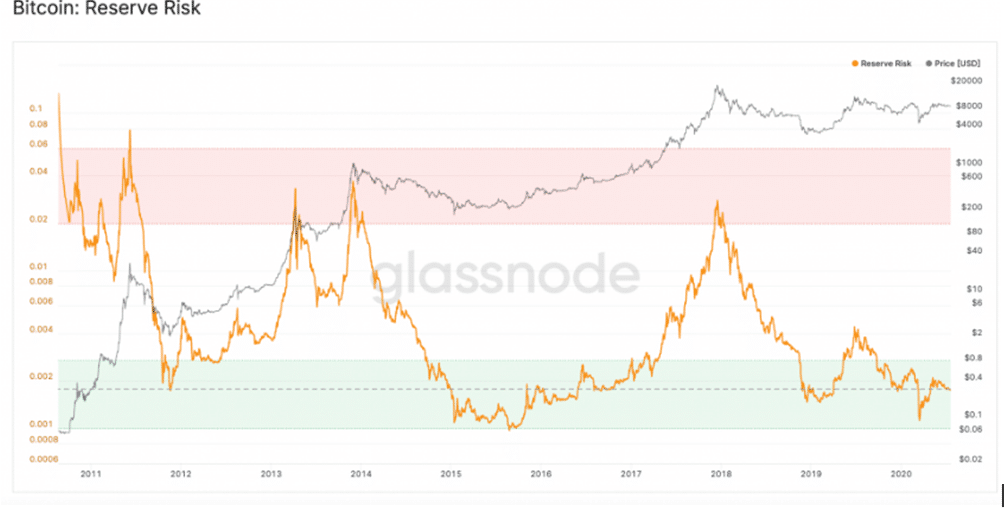What is Bitcoin reserve risk?
According to Hans Hauge, reserve risk is an indicator that measures the risk/reward of investing in Bitcoin based on long-term holders’ convictions. Reserve risk is a simple ratio of the present price of Bitcoin and the long-term conviction of long-term holders of the currency. Long-term holders/investors’ convictions can be quantified as the opportunity cost of not selling, and the current price can be viewed as the incentive to do so.
How does it work?
Reserving risk is a measure of the risk-reward balance in relation to long-term holders’ confidence and belief. Because of this, buying at a low price when the confidence in the market is low is a favorable risk/reward opportunity. Oversold (green) values are below 0.002, and overbought (red) values are over 0.002. (red). In the past, each market cycle’s peak has occurred in this overbought area. In contrast, bottoms have been reached within the oversold territory.

Reserving risk indicator principles
The principles underlying reserve risk can be summarized as follows:
- Coin-days are a measure of how long a coin has lain dormant until it is spent. This is a useful technique for gauging the level of conviction of HODLers with strong hands.
- The desire to sell and make a profit rises in tandem with the price rises. This is why HODLers tend to spend their coins as bull markets gain momentum.
- This collaborative effort builds up an “opportunity cost” because the stronger hands resist the impulse to sell. In the long run, the cumulative ‘opportunity cost’ of HODLers who actively choose not to sell grows, creating the HODL bank.
- This ‘opportunity cost’ is calculated by dividing the current price (an incentive to sell) by the reserve risk ratio (HODL bank). To put it another way, Reserve Risk measures how well HODLers have resisted selling pressure.
Coin Days Destroyed (CDD)
There are “coin days” associated with how long a coin has been lying dormant in your wallet. Moving a Bitcoin after it has been dormant for some time “destroys” the number of days it has accumulated. Consider the following scenario: if I purchase 1 Bitcoin and hold it for 7 days when I remove that Bitcoin from my wallet, the Bitcoin days are regarded to have been destroyed. After seven days, a single BTC would have wiped out seven Bitcoin Days if it was traded (7 BDD).
To calculate coin days destroyed, a person’s movement during that day is multiplied by the number of days those coins had been inactive. The total number of coin days destroyed in a day is provided by this figure. When looking at this indicator, it is possible to determine whether or not the Bitcoins moving through the network are coming from new or old investors.
A coin day is gained for each day that a coin remains unspent; in the same manner, a coin day is lost when the coin is spent. The CDD (Coin Days Destroyed) indicator is correlated to this value. The desire to sell increases in direct proportion to the increase in price.
Because of the Bitcoin blockchain’s inherent openness, anyone can see the exact number of days a coin has been kept and/or spent. An abundance of CDD on a given day indicates that old coins are being spent or traded. We can further standardize the metric for an increased circulation supply by dividing CDD by circulating supply.
Due to their strong conviction and lack of profit, holders of CDD will not see an increase in CDD despite an increase in the price.
CDD’s median value of coin days destroyed (MVOCDD) is a little deviation from the standard formula. We multiply the median CDD value by the current BTC price (grey line). In other words, when the price and MVOCDD diverge, the majority of holders aren’t ready to sell.

The difference between the advertised price and what investors actually spend might be viewed as an opportunity cost of not selling the asset. It is then referred to as the HODL bank, which is a sum total of all the lost opportunities (green). The Reserve Risk indicator uses the HODL bank as the denominator.
Hodl decreases when the price of BTC (black circles) rises above the price of MVOCDD (white circles). Bitcoin days are being created at a faster rate than they are being destroyed for every day that MVOCD does not surpass the price of Bitcoin. The holder bears the opportunity cost of this. This means that holding on to a Bitcoin today that is worth $40,000 on the open market means that I have forfeited $40,000 in order to maintain my position.
In summary
The age of the coins being moved can be used to distinguish between long-term investors and speculative dealers when assessing demand. More accurate market participants are reflected in Bitcoin days by attributing a higher value to coins that have remained idle for a longer period of time. Essentially, Reserve Risk estimates the risk-to-reward ratio of investing in Bitcoin based on long-term holders’ beliefs. Measurement is based on a comparison of current market prices to long-term holders’ resistance to the desire to sell.




